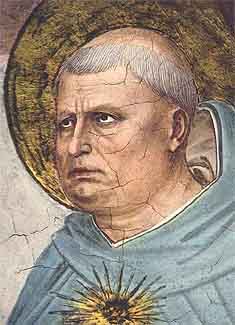
Sunday, 28 January, was the feast of
St. Thomas Aquinas (Tomaso Aquino). He was 1 of the greatest philosophers & theologians in the Catholic Church. The influence of his writings is felt throughout the Church & far beyond. So important was what he wrote that he has been named a Doctor of the Church. St. Thomas is known as the Angelic Doctor. He was Born at Rocca Secca in the Kingdom of Naples, 1225 or 1227; died at Fossa Nuova, 7 March, 1274.
Does the cheese stand alone?
It seems that the cheese does not stand alone:
Objection 1: There are many dairy products such as milk, yogurt, cream, half and half and the like. In the natural world, all stand together with the cheese in the dairy isle and freezer section, therefore the cheese does not stand alone.
Objection 2: The tradition handed down by the FDA has always grouped cheese with other dairy products and as leading to your daily dairy intake. As such, the cheese does not stand alone.
Objection 3: It is not in the nature of cheese to stand as it has no legs or any other standing apparatus and since, as the Philosopher says, “nature is a source or cause of being moved and of being at rest” (Physics I, ii), nothing can do what is not in its nature. Thus the cheese does not stand alone because it cannot stand at all.
Objection 4: It is said that “milk does a body good” and therefore is great. Therefore the cheese does not stand alone, but with the milk.
Objection 5: In the Holy Land per se, also known as Wisconsin or Land that is inherently Holy, cheese is not the only object of fame. For Wisconsin is also known for polka, toilets, tamales, fireworks, and bubblers. The cheese must, then, stand with all of these and not alone.
On the contrary: The Poet says, “Hi-ho the derry-o, the cheese stands alone.”
I answer that: The cheese stands alone in two ways. Firstly, among dairy products it is the most pungent and therefore the most easily identifiable by smell and taste. It is also the most carefully crafted of all dairy products as well as the most diverse in kind. As what is most important is given the most attention, the cheese is unique among dairy products and stands alone as one.
Secondly, cheese by its very nature is holy. Some cheeses have a greater actuality of their holiness, such as Edamer or Swiss. (Note that this is why the Swiss Guards are only allowed into the Vatican after consuming exorbitant amounts of Swiss cheese.) Other cheeses have a lesser actuality, such as Cheddar or Brie. Nevertheless, this holiness is possessed by each cheese essentially regardless of its actuality. As such, cheese is necessarily holy, unlike other foods, and therefore stands alone.
Reply Objection 1: The word ‘alone’ can be used in two different senses; the first existing individually and in solitude, the second existing in a class of its own above all else to which it is compared. The Poet uses ‘alone’ in the latter sense while the objection applies to the former.
Reply Objection 2: There are two types of grouping, metaphysical and effectual. Metaphysical groups mark out something regarding what it is while effectual groups mark out something according to the result it produces. The FDA’s grouping is an effectual one as it means that all those in its group result in a healthy body. However, thee cheese stands alone metaphysically.Moreover, there are two types of tradition, for tradition depends upon authority. A contingent tradition is dependent on a temporal authority, while a universal tradition does not. The FDA is a temporal authority, has a contingent tradition, and therefore can not speak on the metaphysical matters at hand.
Reply Objection 3: The word ‘stand’ can not only be used properly, i.e. by the means of legs, but also analogically, i.e. “I should stand up to him” or “Stand proud”. Regarding the cheese, stand is used analogically and therefore does not require legs or any physical organ of standing.
Reply Objection 4: It is also said, “Behold the power of cheese.” Cheese has a power that strikes fear into the hearts of men. As fear is a gift of the Holy Spirit, cheese has a greater power than milk and stands above it and alone.
Reply Objection 5: Cheese is not native to Wisconsin, nor is it found only in Wisconsin as it is commonly found in France, Italy and the like. As such, it is not associated with Wisconsin per se but per accidens. Hence it is only accidentally associated with bubblers, polka, etc. So it does not stand with them per se but per accidens. Thus, the cheese stands alone per se.
Whether borogroves are all mimsy
Objection 1. It would seem that borogroves are not all mimsy. For to say that one thing is all or entirely another is to say that the idea of the first thing is entirely contained in the idea of the second. But mimsiness is, as the Philosopher states (
Organon), an accident, while a borogrove is a substance. And no substance can be an accident. Therefore borogroves cannot be all mimsy.
Objection 2. Further, borogroves are subject to change, which implies that either their mimsiness changes, in which case as its mimsy diminishes a borogrove cannot be all mimsy, that is to say, the perfection of mimsiness; or that something other than their mimsiness changes, in which case it is manifest that the borogrove is not entirely mimsy.
On the contrary, Lewis Carroll states, "All mimsy were the borogroves."
I answer that, to say that borogroves are all mimsy can be understood in three ways. First, in the sense that borogroves belong to mimsy as a species to a genus. Second, that borogroves always possess complete mimsy. Third, that under certain circumstances borogroves possess complete mimsy, and it is in this third sense that we understand the borogroves to be all mimsy.
Reply to Objection 1. This is the first sense, of relating species to genus, and this is not the sense intended.
Reply to Objection 2. This is the second sense, but that this is not the sense intended is shown by Lewis Carrol's observation that "'Twas brillig," implying that, if 'twasn't brillig, the borogroves would not necessarily be all mimsy.
Image credits:
1st: Depiction of St. Thomas Aquinas from the Demidoff Altarpiece by Carlo Crivelli.
2nd: St. Thomas Aquinas by Fra Angelico.

 mas' greatest work, & 1 that any amateur or professional philosopher or theologian needs must be familiar with, is the Summa Theologica. Throughout the years I have come across many great humorous take-offs on his method of philosophical debate (which was nothing more than the accepted form of the time). They have dealt with such burning issues as Proving the Existance of Santa Claus & Is God Made of Soap? Thanks to Dad29 I now have the answers to 2 more burning issues, Does the cheese stand alone? & Whether borogroves are all mimsy? Read on to find out:
mas' greatest work, & 1 that any amateur or professional philosopher or theologian needs must be familiar with, is the Summa Theologica. Throughout the years I have come across many great humorous take-offs on his method of philosophical debate (which was nothing more than the accepted form of the time). They have dealt with such burning issues as Proving the Existance of Santa Claus & Is God Made of Soap? Thanks to Dad29 I now have the answers to 2 more burning issues, Does the cheese stand alone? & Whether borogroves are all mimsy? Read on to find out:








1 Comments:
At 29/1/07 8:27 AM , Brother James said...
Brother James said...
And what are toves when they are not slithy? Can toves be all mimsy, and the borogoves slithy? Sniker-snack, the argument ends..
Post a Comment
Subscribe to Post Comments [Atom]
<< Home